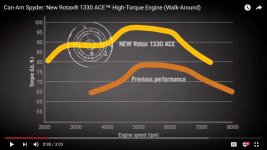AeroPilot
Member
Recommended RPM to shift up
"At what RPM is it recommended that you shift up?" Since the OP was referencing the 1330 SE6 platform specific to the F3 bike, I suggest that he learn to shift by "feeling" and listening to his bike, with the guide of the ECO recommended shift points! I dont own his ryde and I doubt that I ryde like him, but BRP has provided a very good learning tool that will keep his bike revving and singing for a long time should he choose to learn from his bike starting with the engineers "suggested" shift points. My wife rides her 16 F3 and has over 50,000 miles on the 1330 SE6 platform, and I would NEVER suggest how she should shift and ryde her ryde!!
I would shift down to pass and kick the revs up a bit on my bike and have occasionally mentioned that, but I ryde my 15 RT SE6 and am still adjusting at 25,000 miles. I do recognize that the bike sounds "happy" when it hits the RPM where ECO says it recommends to shift to the next gear, but that green arrow can light up as low as 1700 RPM if I'm poking along on a down grade, and usually 2700 rpm on the flats going from 5th to 6th gear. I only check out the ECO as I am curious about what the BRP engineers seem to think is a good economical shift point for the way the bike RPM and I assume engine torque/vaccuum or other parameters tell it.
Your recommended RPMs will be specific to each shift and road parameter and desire for speed or to "smell the roses" My only suggestion is RYDE, RYDE, RYDE and sense and listen to your ryde. It will tell you when its happy. If you want to learn more about your bike (or your horse), listen to it and spend some time learning how it feels.
"At what RPM is it recommended that you shift up?" Since the OP was referencing the 1330 SE6 platform specific to the F3 bike, I suggest that he learn to shift by "feeling" and listening to his bike, with the guide of the ECO recommended shift points! I dont own his ryde and I doubt that I ryde like him, but BRP has provided a very good learning tool that will keep his bike revving and singing for a long time should he choose to learn from his bike starting with the engineers "suggested" shift points. My wife rides her 16 F3 and has over 50,000 miles on the 1330 SE6 platform, and I would NEVER suggest how she should shift and ryde her ryde!!
I would shift down to pass and kick the revs up a bit on my bike and have occasionally mentioned that, but I ryde my 15 RT SE6 and am still adjusting at 25,000 miles. I do recognize that the bike sounds "happy" when it hits the RPM where ECO says it recommends to shift to the next gear, but that green arrow can light up as low as 1700 RPM if I'm poking along on a down grade, and usually 2700 rpm on the flats going from 5th to 6th gear. I only check out the ECO as I am curious about what the BRP engineers seem to think is a good economical shift point for the way the bike RPM and I assume engine torque/vaccuum or other parameters tell it.
Your recommended RPMs will be specific to each shift and road parameter and desire for speed or to "smell the roses" My only suggestion is RYDE, RYDE, RYDE and sense and listen to your ryde. It will tell you when its happy. If you want to learn more about your bike (or your horse), listen to it and spend some time learning how it feels.

